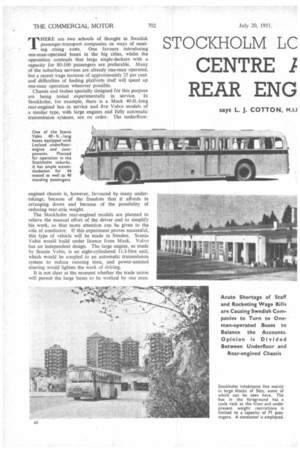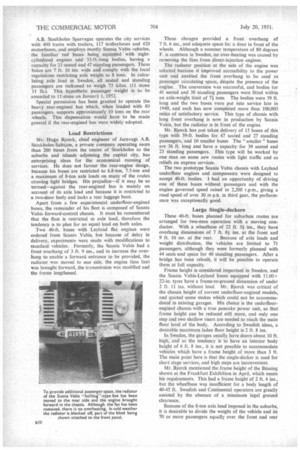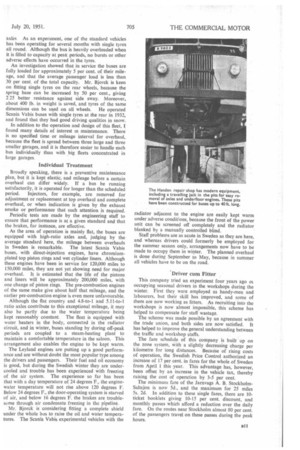STOCKHOLM LC
Page 42

Page 43

Page 44

Page 45

If you've noticed an error in this article please click here to report it so we can fix it.
TO
CENTRE I REAR ENG
says L. J. COTTON, M.i.i THERE are two schools of thought in Swedish passenger-transport companies on ways of meeting rising costs. One favours introducing one-man-operated buses in the big cities, whilst the opposition contends that large single-deckers with a capacity for 80-100 passengers are preferable. Many of the suburban services are already one-man operated, but a recent wage increase of approximately 25 per cent. and difficulties of finding platform staff will speed up one-man operation wherever possible.
Chassis and bodies specially designed for this purpose are being tested experimentally in service. In Stockholm, for example, there is a Mack 40-ft.-long rear-engined bus in service and five Volvo models of a similar type, with large engines and fully automatic transmission systems, are on order. The underfloor engined chassis is, however, favoured by many undertakings, because of the freedom that it affords in arranging doors and because of the possibility of reducing rear-axle weight.
The Stockholm rear-engined models are planned to relieve the manual effort of the driver and to simplify his work, so that more attention can be given to the role of conductor. If this experiment proves successful, this type of vehicle will be made in Sweden. Scania Vabis would build under licence from Mack. Volvo has an independent design. The large engine, as made by Scania Vabis, is an eight-cylindered 11.3-litre unit, which would be coupled to an automatic transmission system to reduce running time, and power-assisted steering would lighten the work of driving.
It is not clear at the moment whether the trade union will permit the large buses to be worked by one man.
The Mack bus in Stockholm is driven by volunteers only, and there may be objections from the trade union.
A.B. Stockholm Sparvagar is the only big municipal undertaking that believes in one-man operation in cities. The buses now used in city service with a stationary conductor are, in fact, most effective, and many people believe that the saving by one-man operation may be absorbed by the higher wages that have to be paid to the driver-conductor, by lower average speed, less passenger capacity and extra cost for automatic transmission, servo steering and safety device's. It is also felt that one-man operation in the cities will increase loading and unloading time, which will further add to traffic congestion. With the rear-engined bus, the frame height and, therefore, the body floor level, can be kept low, thus speeding up entry and exit at stopping points. There is ample space for the front entrance platform, adjacent to the driver, and for the double door exit at the centre. The rear-engined buses are to be tried in the city, where there is a total population of 700,000, and in the outer zones of Greater Stockholm, which now has approximately Im. inhabitants.
In the city zone there is a basic fare of 5d., which permits a single transfer to any of the bus, tram or trolleybus routes, an.:I there are weekly and monthly passes giving a reduction of 30 per cent, over the daily
rates. These passes are used mostly, by passengers
travelling in the peak periods, and help to reduce the time required for fare collection at each point. Double fares are charged after midnight.
There is an increase of If& above the basic rate for passengers travelling from the city zone, and an additional Ltd. for travelling to the outskirts of the operating area. With two-man operation and the former rate of pay for drivers and conductors, the transport system suffered a heavy deficit, approximately 20 per cent, at least being in the city area and the remainder in the outer zones. Because of the flat nature of the country, bicycles are popular, and many people prefer to cycle rather than pay increased fares,
A.B. Stockholm Spa rvagar operates the city services with 400 trams with trailers, 117 trolleybuses and 420 motorbuses, and employs mostly Scania Vabis vehicles, the familiar red buses being equipped with eightcylindered engines and 33-ft.-long bodies, having a capacity for 23 seated and 47 standing passengers. These buses are 7 ft. 10 ins, wide and comply with the local regulations restricting axle weight to 8 tons. In calculating axle load in Sweden, all seated and standing passengers are reckoned to weigh 75 kilos. (11 stone 11 lb.). This hypothetic passenger weight is to be amended to 11 stone on January 1, 1952.
Special permission has been granted to operate the heavy rear-engined bus which, when loaded with 80 passengers, supports approximately 10 tons on the rear wheels. This dispensation would have to be made general if the rear-engined bus were widely adopted.
Load Restrictions Mr. Hugo Bjorck, chief engineer of Jarnvags A.B. Stockholm-Saltsjon, a private company operating more than 200 buses from the centre of Stockholm to the suburbs and islands adjoining the capital city, has enterprising ideas for the economical running of services. He does not favour the rear-engine design, because his buses are restricted to 6.8-ton, 7.5-ton and a maximum of 8-ton axle loads on many of the routes crossing light bridges. His prejudice—if it may be so termed—against the rear-engined bus is mainly on account of its axle load and because it is restricted to a two-door body and lacks a rear luggage boot.
Apart from a few experimental underfloor-engined buses, the remainder of his fleet is composed of Scania Vabis forward-control chassis. It must be remembered that the fleet is restricted in axle load, therefore the tendency is to plan for an equal load on both axles.
Two 40-ft. buses with Leyland flat engines were ordered from Scania Vabis, but because of delay in delivery, experiments were made with modifications to standard vehicles. Formerly, the Scania Vabis had a front overhang of 3 ft. 9 ins., and to increase the overhang to enable a forward entrance to be provided, the radiator was moved to one side. the engine (less fan) was brought forward, the transmission was modified and the frame lengthened.
These changes provided a front overhang of 7 ft. 6 ins., and adequate space fo: a door in front of the wheels. Although a summer temperature of 80 degrees F. is common in Sweden, no over-heating was caused by removing the fans from direct-injection engines.
The radiator position at the side of the engine was selected because it improved accessibility to the power unit and enabled the front overhang to be used as passenger circulating space, despite the presence of the engine. The conversion w as successful, and bodies for 41 seated and 30 standing passengers were fitted within an axle-weight limit of 7i tons The bodies were 39 ft. long and the two buses were put into service late in 1949, and each has now completed more than 100,009 miles of satisfactory service, This type of chassis with long front overhang is now in production by Scania Vabis, but the radiator is in front of the engine.
Mr. Bjorck has just taken delivery of 15 buses of this type with 39-ft. bodies for 47 seated and 27 standing passengers, and 10 smaller buses The " smaller " buses are 36 ft. long and have a capacityfor 39 seated and 23 standing passengers. This type will be worked by one man on some new routes with light traffic and as reliefs on express services.
The two prototype Scania Vabis chassis with Leyland underfloor engines and components were designed to accept 40-ft. bodies. I had an opportunity of -driving one of these buses without passengers and with the engine governed speed raised to 2,200 r.p.m., giving a road speed of over 30 m p.h. in third gear, the performance was exceptionally good.
Large Single-deckers
These 40-ft. buses planned for suburban routes are arranged for two-man operation with a moving conductor. With a wheelbase of 22 ft. 3i ins., they have overhang dimensions of 7 ft. 8i ins, at the front and 9 ft. 10 ins, at the rear. Because of axle loads and weight distribution, the %aides are limited to 71 passengers, although they were formerly planned with 44 seats and space for 40 standing passengers. After a bridge has been rebuilt, it will be possible to operate them at full capacity.
Frame height is considered important in Sweden, and the Scania Vabis-Leyland buses equipped with 11.00x 22-in. tyres have a frame-to-ground dimension of under 2 ft. 11 ins, without load. Mr. Bjorck was critical of the chassis height of current underfloor-engined models, and quoted some makes which could not be accommodated in existing garages. His choice is the underfloorengined chassis, with a true pancake power unit, so that frame height can be reduced still more, and only one step and two shallow risers are needed to reach the main floor level of the body. According to Swedish ideas, a desirable maximum laden floor height is 2 ft. 8 ins.
In Sweden, the garages usually have doors about 10 ft. high, and as the tendency is to have an interior body height of 6 ft. 8 ins., it is not possible to accommodate vehicles which have a frame height of more than 3 ft. The main point here is that the single-decker is used for short stage services, and high steps are inconvenient.
Mr. Bjorck mentioned the frame height of the Bussing shown at the Frankfurt Exhibition in April, which meets his requirements. This had a frame height of 2 ft. 4 ins., but the wheelbase was insufficient for a body length of 40-45 ft. Swedish and Continental operators are greatly assisted by the absence of a minimum legal ground clearance.
Because of the 8-ton axle load imposed in the suburbs, it is desirable to divide the weight of the vehicle and its 70 or more passengers equally over the front and rear axles As an experiment, one of the standard vehicles has been operating for several months with single tyres all round. Although the bus is heavily overloaded when it is filled to capacity at peak periods, no bursts or other adverse effects have occurred in the tyres.
An investigation showed that in service the buses are fully loaded for approximately 5 per cent, of their mileage, and that the average passenger load is less than 30 per cent, of the total capacity. Mr. Bjorck is keen on fitting single tyres on the rear wheels, because the spring base can be increased by 50 per cent., giving 2.25 better resistance against side sway. Moreover, about 400 lb. in weight is saved, and tyres of the same dimensions can be used on all wheels. He operated Scania Vabis buses with single tyres at the rear in 1932, and found that they had good driving qualities in snow.
In addition to the operation and design of this fleet, I found many details of interest in maintenance. There is no specified time or mileage interval for overhaul, because the fleet is spread between three large and three smaller garages, and it is therefore easier to handle each bus individually than with .big fleets concentrated in large garages Individual Treatment Broadly speaking, there is a preventive maintenance plan, but it is kept elastic, and mileage before a certain overhaul can differ widely. If a bus be running satisfactorily, it is operated for longer than the scheduled period. Injectors, for example, are removed for adjustment or replacement at top overhaul and complete overhaul, or when indication is given by the exhaust smoke or performance that such attention is required.
Periodic tests are made by the engineering staff to ensure that performance is at a given standard and that the brakes, for instance, are effective.
As the area of operation is mainly flat, the buses are equipped with high-ratio axles and, judging by the average standard here, the mileage between overhauls in Sweden is remarkable. The latest Scania Vabis buses, with direct-injection engines, have chromiumplated top piston rings and wet cylinder liners. Although these engines have been in service for 120,000 miles to 150,000 miles, they are not yet showing need for major overhaul. It is estimated that the life of the pistons and liners will be approximately 200,000 miles, with one change of piston rings. The pre-combustion engines of the same make give about half that mileage, and the earlier pre-combustion engine is even more unfavourable.
Although the flat country and 4.8-to-1 and 5.11-to-1 ratio axles contribute to this exceptional mileage, it may also be partly due to the water temperature being kept reasonably constant. The fleet is equipped with water heaters in the body, connected in the radiator circuit, and in winter, buses standing by during off-peak periods are coupled to a steam-heating plant to maintain a comfortable temperature in the saloon. This arrangement also enables the engine to be kept warm.
The Leyland engines are putting up a good performance and are without doubt the most popular type among the drivers and passengers. Their fuel and oil economy is good, but during the Swedish winter they are undercooled and trouble has been experienced with freezing of the air system. The experience so far has been that with a day temperature of 24 degrees F., the enginewater temperature will not rise above 120 degrees F. Below 24 degrees F., the door-operating system is starved of air, and below 16 degrees F. the brakes are troublesome through air condensate freezing in the pipeline.
Mr. Bjorck is considering fitting a complete shield tinder the Whole bus to raise the oil and water temperatures. The Scania Vabis experimental vehicles with the radiator adjacent to the engine are easily kept warm under adverse conditions, because the front of the power unit can be screened off completely and the radiator blanked by a manually controlled blind.
Staff problems are as acute in Sweden as they are here, and whereas drivers could formerly be employed for the summer season only, arrangements now have to be made to occupy them in winter. The planned overhaul is done during September to May, because in summer all vehicles have to be on the road.
Driver cum Fitter This company tried an experiment four years ago at occupying seasonal drivers in the workshops during the winter. First they were employed as handy-men and labourers, but their skill has improved, and some of them are now working as fitters. As recruiting into the workshops is now almost impossible, this scheme has helped to cOmpensate for staff wastage.
The scheme was made possible by an agreement with the trade union, and both sides are now satisfied. It has helped to improve the general understanding between the traffic and workshop staffs.
The fare schedule of this company is built up on the zone system, with a slightly decreasing charge per kilometre for long distances. Because of rising costs of operation, the Swedish Price Control authorized an increase of 17 per cent, in fares for the whole of Sweden from April 1 this year. This advantage has, however, been offset by an increase in the vehicle tax, thereby raising the cost of operation by 3-5 per cent.
The minimum fare of the Jarnvags A. B. StockholmSaltsjon is now 5d., and the maximum for 25 miles 5s. 2d. In addition to these single fares, there are 10ticket booklets giving 10-15 per cent. discount, and monthly passes which afford a reduction over the daily fare. On the routes near Stockholm almost 80 per cent. of the passengers travel on these passes during the peak hours.




















































































